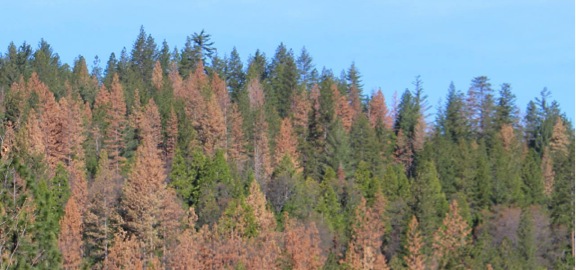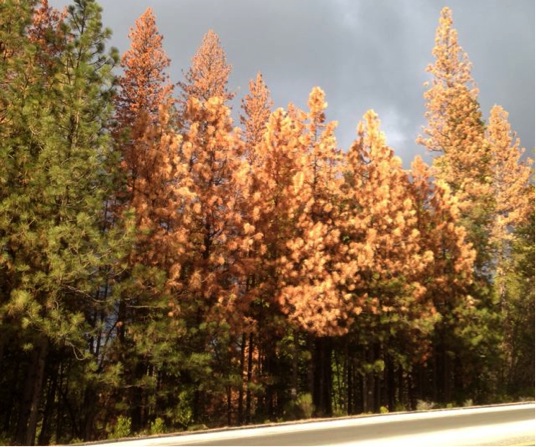 Over the past year, millions of drought-stressed trees have died from bark beetles in the Sierra Nevada. To the south of our local region, in the Sequoia and Sierra National Forests, as many as half of all ponderosa pines and sugar pines have been killed. Forests in Tuolumne County (as shown above) are also suffering extensive damage, but the beetle-caused conifer die-off has not yet been as devastating over in Calaveras County, further north. This winter, the near-normal amount of precipitation has helped to deep-soak parched forest soils. Yet despite the rain and snow, in February and March a new wave of dying conifers became evident. In addition to the pines, white firs are now dying in large numbers as well. The key cause for the fir mortality is the fir engraver (Scolytus ventralis), a small black bark beetle that flies to a tree (often in high numbers), bores an entrance hole, excavates an egg gallery, and lays up to 300 eggs. The larvae feed on the cambium layer underneath the bark, creating a maze of small galleries. If the adult gallery or the larvae galleries girdle the tree, the flow of water and nutrients is blocked – killing the tree. There is no effective control treatment that the Forest Service or private forest owners can utilize to protect vast areas of forest. Bark beetle numbers have soared due to extended periods of warm temperatures over the last four years of drought. High numbers of attacking beetles overwhelm even healthy trees’ ability to expel the beetles with sap. If there are abundant spring rains, adequate water will help stressed conifers recover from the drought and hopefully make them more resistant to beetle attacks. However, if local forests end up suffering through unusually dry weather again next year, then the conifer die-off could become even more extreme across vast portions of our region’s forests. All of those dead trees add to the already extreme build-up of forest fuel, further increasing the risk for another destructive mega-fire.
Over the past year, millions of drought-stressed trees have died from bark beetles in the Sierra Nevada. To the south of our local region, in the Sequoia and Sierra National Forests, as many as half of all ponderosa pines and sugar pines have been killed. Forests in Tuolumne County (as shown above) are also suffering extensive damage, but the beetle-caused conifer die-off has not yet been as devastating over in Calaveras County, further north. This winter, the near-normal amount of precipitation has helped to deep-soak parched forest soils. Yet despite the rain and snow, in February and March a new wave of dying conifers became evident. In addition to the pines, white firs are now dying in large numbers as well. The key cause for the fir mortality is the fir engraver (Scolytus ventralis), a small black bark beetle that flies to a tree (often in high numbers), bores an entrance hole, excavates an egg gallery, and lays up to 300 eggs. The larvae feed on the cambium layer underneath the bark, creating a maze of small galleries. If the adult gallery or the larvae galleries girdle the tree, the flow of water and nutrients is blocked – killing the tree. There is no effective control treatment that the Forest Service or private forest owners can utilize to protect vast areas of forest. Bark beetle numbers have soared due to extended periods of warm temperatures over the last four years of drought. High numbers of attacking beetles overwhelm even healthy trees’ ability to expel the beetles with sap. If there are abundant spring rains, adequate water will help stressed conifers recover from the drought and hopefully make them more resistant to beetle attacks. However, if local forests end up suffering through unusually dry weather again next year, then the conifer die-off could become even more extreme across vast portions of our region’s forests. All of those dead trees add to the already extreme build-up of forest fuel, further increasing the risk for another destructive mega-fire.

